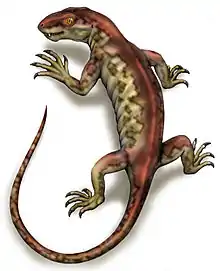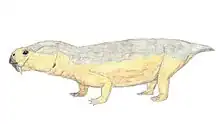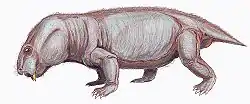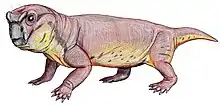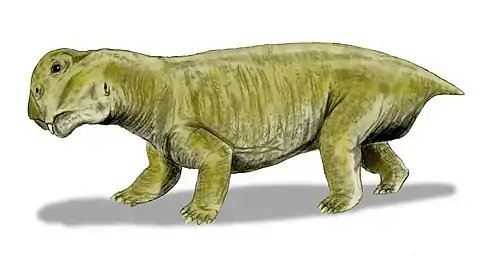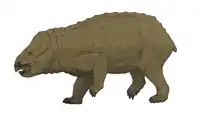| Elphidae Temporal range: | |
|---|---|
| Scientific classification | |
| Domain: | Eukaryota |
| Kingdom: | Animalia |
| Phylum: | Chordata |
| Clade: | Synapsida |
| Clade: | Therapsida |
| Suborder: | †Anomodontia |
| Clade: | †Dicynodontia |
| Clade: | †Bidentalia |
| Family: | †Elphidae Kurkin, 2010 |
| Genera | |
| |
Elphidae is a clade of bidentalian dicynodonts containing Elph, Katumbia, and Interpresosaurus.[1][2] It is exclusively known from the Late Permian of Russia and Tanzania. Elphidae is variously recovered as either at the base of a paraphyletic Cryptodontia,[2] or as basal dicynodontoids.[3]
The clade Elphinae was erected by Kurkin (2010) to pertain to a clade containing Elph and Interpresosaurus, two dicynodonts from Late Permian Russia. This clade was diagnosed by a sharply shortened preorbital skull, relatively small tusks located below the anterior orbit, and maxillae with depressions located below the naris.[4] Elphinae is often recovered forming a clade with the Tanzanian Katumbia,[1] to which the name Elphidae can be applied under the rules of the ICZN.[2]
References
- 1 2 Boos, Alessandra D. S.; Kammerer, Christian F.; Schultz, Cesar L.; Soares, Marina B.; Ilha, Ana L. R. (2016). "A new dicynodont (Therapsida: Anomodontia) from the Permian of southern Brazil and its implications for bidentalian origins". PLOS ONE. 11 (5): e0155000. Bibcode:2016PLoSO..1155000B. doi:10.1371/journal.pone.0155000. PMC 4880204. PMID 27224287.
- 1 2 3 Angielczyk, Kenneth D.; Kammerer, Christian F. (2017). "The Cranial Morphology, Phylogenetic Position and Biogeography of the Upper Permian Dicynodont Compsodon helmoedi Van Hoepen (Therapsida, Anomodontia)". Papers in Palaeontology. 3 (4): 513–545. doi:10.1002/spp2.1087. S2CID 134092461.
- ↑ Kammerer, C. F.; Fröbisch, J. R.; Angielczyk, K. D. (2013). Farke, Andrew A (ed.). "On the Validity and Phylogenetic Position of Eubrachiosaurus browni, a Kannemeyeriiform Dicynodont (Anomodontia) from Triassic North America". PLOS ONE. 8 (5): e64203. Bibcode:2013PLoSO...864203K. doi:10.1371/journal.pone.0064203. PMC 3669350. PMID 23741307.
- ↑ Kurkin, A.A. (2010). "Late Permian Dicynodonts of Eastern Europe". Paleontological Journal. 44 (6): 672–681. doi:10.1134/S0031030110060092. S2CID 131459807.
